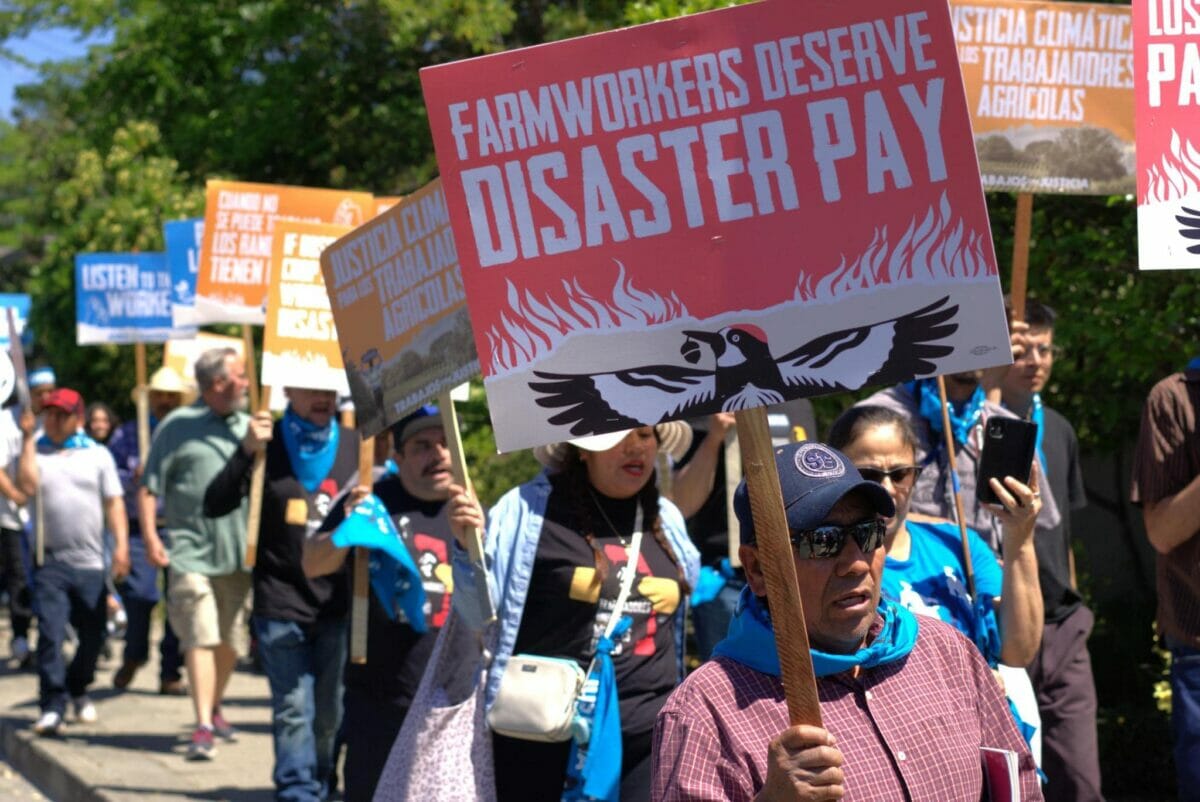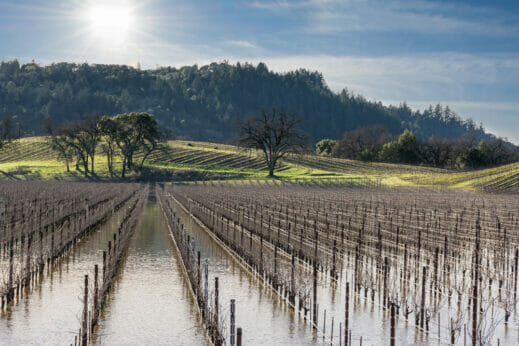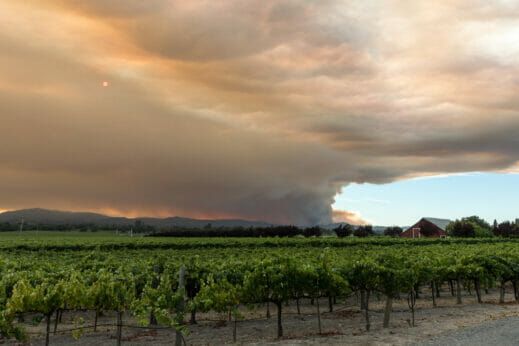Buffeted by fire and flooding, California has moved slowly to provide disaster relief for farmworkers. Despite being better than the status quo, one-off payments are often too little, too late.

For the past two years, farmworkers in California’s Sonoma County have been advocating for stronger labor laws to protect them from the impacts of climate change-fueled disasters, including wildfires, floods and heat waves.
In February, their efforts bore fruit. When residents, including many farmworkers, lost work due to weeks of rainstorms, the county agreed to spend one third of a $3-million disaster relief fund to provide impacted individuals with one-time, $600 payments.
While the fund wasn’t large enough to cover all of the workers’ losses, its creation was a big win, according to Aura Aguilar, an organizer with North Bay Jobs with Justice, a local coalition of labor and community groups leading the campaign.
For the farmworkers advocating for the disaster relief, “it was a really big deal to be able to access these funds and to see the results of their hard work and their fight be seen on a countywide level,” says Aguilar.
The creation of the fund fits into a larger movement pushing for stronger protection and compensation for workers impacted by climate change-fueled disasters. In addition to disaster reimbursements, advocates are pushing for improved social safety net programs for vulnerable workers, hazard pay for those working during climate disasters and greater workplace protections for those impacted by heat, rain or polluted air.
In March, a month after Sonoma County decided to distribute $1 million, the state announced plans for a statewide program to pay undocumented individuals impacted by the storms. However, it ultimately didn’t begin until early June.

A flooded vineyard in Sonoma County. (Photo: Shutterstock)
Michael Méndez, an assistant professor at the University of California, Irvine, who has studied the health effects of wildfires on farmworkers, says that one-off disaster reimbursement programs are a step forward but ultimately insufficient now that the impacts of climate change are so apparent.
“In California, we’re experiencing a major climate change crisis. Year after year, month after month, we’re experiencing climate-induced disasters such as wildfires, heat waves, drought and now, of course, flooding,” says Méndez, adding that, again and again, undocumented workers are hardest hit in part because they are not covered by many social safety net programs.
What’s needed, according to Méndez, is “a permanent stable disaster fund that is readily available whenever these disasters strike instead of waiting months or even a half a year to provide the necessary resources needed to these workers and their families.”
[RELATED: California Farms and Farmworkers Attempt to Recover From Record Floods]
With a new bill, SB 227, California could set up a more permanent “safety net” for farmworkers, 75 percent of whom are undocumented, according to the UC Merced Community and Labor Center. On May 30, days before the state announced its program to reimburse those impacted by floods, the state Senate approved the bill, which would allow undocumented workers to collect unemployment insurance of up to $300 per week for up to 20 weeks.
However, Méndez isn’t holding out hope that California Gov. Gavin Newsom will sign the legislation. The governor vetoed similar legislation last year and the state is currently facing a massive budget deficit.
Another proposal North Bay Jobs with Justice and other groups advocate for is hazard pay for workers working in areas with low air quality or other dangerous conditions.
Hazard pay policies were popular in the first year of the COVID-19 pandemic, with dozens of California municipalities passing laws temporarily requiring some employers to boost wages for front-line workers at greater risk of infection from the virus.
However, despite being considered “essential,” agricultural workers were largely left out of those policies. A list of local hazard pay ordinances maintained by the UC Berkeley Labor Center shows that, out of 35 laws, only one, passed in the Central Valley city of Coachella, gave farmworkers hazard pay. Most of the ordinances boosted pay for grocery and retail employees.
While governments have not mandated hazard pay, at least two employers have agreed to offer it. Wine industry giant E. & J. Gallo Winery reportedly agreed to hazard pay in its latest contract with the United Farm Workers. And Sonoma Valley’s Eco Terreno Wines & Vineyards, a high-end, eco-friendly winery, announced it will offer hazard pay when air quality levels get to unsafe levels.

Smoke from 2020’s Walbridge Fire floats over a Sonoma County vineyard. (Photo: Shutterstock)
Looming in the background of the current movement for farmworker rights is a decades-long legal tradition of treating farmworkers differently from other workers, according to John Logan, a labor history professor at San Francisco State University.
Several foundational pieces of legislation, including the National Labor Relations Act of 1935, specifically excluded farmworkers from protections extended to workers in other industries.
That legal history has contributed to making agriculture one of the least unionized sectors of the American economy, with only a few states, including California, passing laws protecting farmworkers’ right to organize unions. Even in California, union organizing among farmworkers has declined for decades.
“The United Farm Workers Union has been most closely associated with farmworker organizing, and [it] has declined dramatically since the peak in the ‘60s and ‘70s,” says Logan. “At its height, it had between 50,000 and 60,000 members, down to about 5,000 or 6,000 today.”
According to the Bureau of Labor Statistics, 10.1% of all American workers were union members in 2022, compared to 3.9% of workers in agriculture and related industries. Other estimates put the rate of unionized farmworkers even lower.
Last year, Newsom, under pressure, signed a law that allows farmworkers to vote in union elections by mail-in ballots rather than in person, a change that labor advocates hope will shield workers from possible intimidation by employers. It’s too soon to tell how much of an effect the law will have.
For Aguilar, the North Bay Jobs with Justice organizer in Sonoma County, the struggle comes back to how crucial farmworkers are.
“The wine industry would not exist without the skilled labor of farmworkers. That’s the reality. So any sort of compensation or any sort of funds that can go towards just respecting and dignifying farmworkers, I think that should be the priority,” she says.
The farmworkers need the support. However, Newsom has made CA a disaster area, statewide. Present budget deficit over $30 billion and climbing. $800 billion public pension shortfall happening. People fleeing the state, including high taxpayers.
Lately, I often see many natural disasters in California on TV. This is terrible. I don’t know what I would do if I was in such a situation. The locals here are greatly affected. Hopefully, the local government will take measures as well as timely support to help people here.
I hope they keep supporting our farmworkers. They work really hard are less appreciated
Seems the Sun’s solar flares are raising earth temperature. Fix that one California